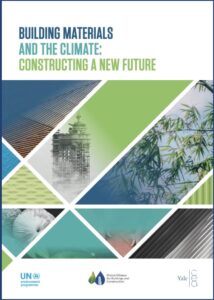UN report addresses emissions in the construction sector
A report published today by the UN Environment Programme (UNEP) and the Yale Center for Ecosystems + Architecture (Yale CEA), under the Global Alliance for Buildings and Construction (GlobalABC), outlines pathways to decarbonise the buildings and construction sector, which is responsible for 37% of global CO2 emissions.
 The report, ‘Building materials and the climate: Constructing a new future’, offers a three-pronged, Avoid-Shift-Improve solution which they believe needs to be adopted throughout the building process to slash emissions. They also point out that the solution requires sensitivity to local cultures and climates, including the common perception of concrete and steel as modern materials of choice.
The report, ‘Building materials and the climate: Constructing a new future’, offers a three-pronged, Avoid-Shift-Improve solution which they believe needs to be adopted throughout the building process to slash emissions. They also point out that the solution requires sensitivity to local cultures and climates, including the common perception of concrete and steel as modern materials of choice.
Avoid waste through a circular approach: building less by repurposing existing buildings is the most valuable option, generating 50-75 per cent fewer emissions than new construction; promote construction with less materials and with materials that have a lower carbon footprint and facilitate reuse or recycle.
Shift to ethically and sustainably sourced renewable bio-based building materials, including timber, bamboo, and biomass. The shift towards properly managed bio-based materials could lead to compounded emissions savings in many regions of up to 40 per cent in the sector by 2050. However, more policy and financial support is needed to ensure the widespread adoption of renewable bio-based building materials.
Improve decarbonisation of conventional materials that cannot be replaced. This mainly concerns the processing of concrete, steel, and aluminium – three sectors responsible for 23 per cent of overall global emissions today – as well as glass and bricks. Priorities should be placed on electrifying production with renewable energy sources, increasing the use of reused and recycled materials, and scaling innovative technologies. Transformation of regional markets and building cultures is critical through building codes, certification, labelling, and the education of architects, engineers, and builders on circular practices.
Sheila Aggarwal-Khan, Director of UNEP’s Industry and Economy Division said: ‘Until recently, most buildings were constructed using locally sourced earth, stone, timber, and bamboo. Yet modern materials such as concrete and steel often give only the illusion of durability, usually ending up in landfills and contributing to the growing climate crisis.
‘Net zero in the building and construction sector is achievable by 2050, as long as governments put in place the right policy, incentives and regulation to bring a shift the industry action.’
Anna Dyson, Founding Director of Yale CEA said: ‘Since the built environment sector is so complex, with interdependencies across actors, all hands on deck are required to decarbonise, and we can’t leave anyone behind. Policies must support the development of new cooperative economic models across the building, forestry and agricultural industries, in order to galvanise a just transition towards circular, bio-based material economies that can also work synergistically with the conventional material sectors.’

















